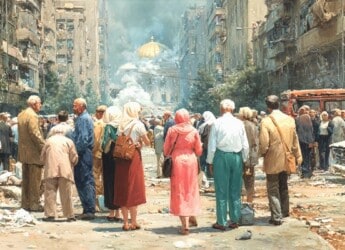|
|
Content Assessment: Organized Withdrawal? Ukraine Conflict Assessments in Maps (October 17 - 21, 2022)
Information - 96%
Insight - 97%
Relevance - 95%
Objectivity - 94%
Authority - 96%
96%
Excellent
A short percentage-based assessment of the qualitative benefit of the post highlighting the recent Ukraine conflict assessments in maps from the Institute for the Study of War.
Editor’s Note: One of the most accurate and detailed sources for ongoing updates on the Ukraine crisis is the Ukraine Conflict Update from the Institute for the Study of War. The Institute for the Study of War (ISW) is a 501(c)(3) organization and produces strictly non-partisan, non-ideological, fact-based research. ISW seeks to promote an informed understanding of war and military affairs through comprehensive, independent, and accessible open-source research and analysis. ISW’s research is made available to the general public, military practitioners, policymakers, and media members. Providing a daily synthesis of key events related to the Russian aggression against Ukraine, ISW updates may benefit cybersecurity, information governance, and legal discovery professionals as they follow the business, information technology, and legal trends and trajectories impacted by and stemming from the current Ukraine conflict.
Assessment and Maps*
Ukraine Conflict Assessments – An Overview in Maps
- Institute for the Study of War (ISW), Russia Team
- Critical Threats Project (CTP), American Enterprise Institute
General Assessment Background Info
- ISW systematically publishes Russian campaign assessments that include maps highlighting the assessed control of terrain in Ukraine and main Russian maneuver axes.
- These maps augment daily synthetic products that cover key events related to renewed Russian aggression against Ukraine.
The Russian Offensive Campaign Assessments
- October 21, 2022
- By Katherine Lawlor, Grace Mappes, Kateryna Stepanenko, George Barros, and Frederick W. Kagan
Key Development
- The Russian withdrawal from western Kherson Oblast has begun. Russian forces likely intend to continue that withdrawal over the next several weeks but may struggle to withdraw in good order if Ukrainian forces choose to attack. Russian officials have remained cagey about whether or not Russian President Vladimir Putin has ordered a withdrawal from Kherson and are likely continuing to prepare the information space for such a collapse, as ISW has previously assessed.
Key Takeaways
- The Russian withdrawal from western Kherson Oblast has begun. Russian forces likely intend to continue that withdrawal over the next several weeks but may struggle to withdraw in good order if Ukrainian forces choose to attack.
- Russian President Vladimir Putin is demonstrably setting conditions for Russia to continue a protracted war in Ukraine, not for a negotiated settlement or offramp.
- Russian forces will likely attempt to blow up the dam at the Kakhovka Hydroelectric Power Plant (HPP) to cover their withdrawal from Kherson City and to prevent Ukrainian forces from pursuing Russian forces deeper into Kherson Oblast.
- Russian President Vladimir Putin signed a decree on October 21 creating a Russian government “coordination council” to improve wartime federal coordination.
- Russian and Ukrainian sources reported fighting northeast of Kharkiv City along the international border, on the Svatove-Kreminna frontline, and west of Lysychansk.
- Ukrainian military officials offered a limited overview of the situation on the frontline.
- Ukraine’s Southern Operational Command emphasized that Russian forces are using Ukrainian civilians as human shields when transporting military equipment across the Dnipro River, while Russian sources released footage showing a line of civilians awaiting the ferry from Kherson City.
- Russian forces continued ground attacks in Donetsk Oblast and routine fire west of Hulyaipole and in Mykolaiv Oblast.
- Russian authorities are attempting to maintain the façade of sustainable and strong logistics in southern Ukraine while accelerating measures to compensate for the Kerch Strait Bridge attack.
- Fissures between regional Russian officials, the Russian Ministry of Defense (MoD) and military commissariats, and the Russian civilian population from which mobilization draws will likely intensify in the coming months.
- Russian authorities are preventing Ukrainians in Russia from leaving Russia with complex residency and permit requirements to cross international borders.
- Russian occupation authorities continued the mass forced removal of civilians from the west bank of the Dnipro River under the guise of civilian “evacuations.”
- October 20, 2022
- By Karolina Hird, Katherine Lawlor, Riley Bailey, George Barros, Nicholas Carl, and Frederick W. Kagan
Key Development
- Russia is likely continuing to prepare for a false flag attack on the Kakhovka Hydroelectric Power Plant (HPP). Ukrainian President Volodymyr Zelensky stated on October 20 that Russian forces mined the dam of the Kakhovka HPP and noted that the HPP holds over 18 million cubic meters of water, which would cause massive and rapid flooding of settlements along the Dnipro River, including Kherson City.
Key Takeaways
- Russia is likely continuing to prepare for a false-flag attack on the Kakhovka Hydroelectric Power Plant (HPP).
- Russian forces are likely setting conditions to remove military and occupation elements from the west bank of the Dnipro River in anticipation of imminent Ukrainian advances.
- The White House confirmed on October 20 that Iranian military personnel are in Russian-occupied Crimea, Ukraine to assist Russian forces in conducting drone attacks on Ukrainian civilians and civilian infrastructure.
- Iran is providing military support to Russian forces in Ukraine despite new international sanctions likely in part because Iranian leaders believe that they need Moscow’s help to upend the US-led global order.
- Russian sources continued to claim that Russian forces are consolidating limited regained positions in northeastern Kharkiv Oblast on October 20 despite Ukrainian reports that Ukraine has liberated all but 1.8% of Kharkiv Oblast.
- Russian sources indicated that Ukrainian troops have advanced in northern Kherson Oblast as Ukrainian forces continued their interdiction campaign.
- Russian forces continued to conduct ground assaults in Donetsk Oblast but Russian sources contradicted their own claims on control of Bakhmut. Russian forces are likely continuing to falsify claims of advances in the Bakhmut area to portray themselves as making gains in at least one sector amid continuing losses in northeast and southern Ukraine.
- Russian regional governments and the Russian Ministry of Defense (MoD) continue to blame each other for military administrative failures.
- October 19, 2022
- By Katherine Lawlor, Karolina Hird, Grace Mappes, Riley Bailey, George Barros, and Frederick W. Kagan
Key Development
- Russian authorities are likely setting information conditions to justify planned Russian retreats and significant territorial losses in Kherson Oblast. Commander of Russian Armed Forces in Ukraine Army General Sergey Surovikin reported during an appearance on Russian television that the Russian military leadership has to make “difficult decisions” regarding Kherson Oblast and accused Ukraine of planning to strike civilian and residential infrastructure in Kherson Oblast.
Key Takeaways
- Russian authorities are likely setting information conditions to justify planned Russian retreats and the loss of significant territory in Kherson Oblast.
- Russian forces are setting information conditions to conduct a false-flag attack on the Kakhovka Hydroelectric Power Plant (HPP); the Russian military may believe that breaching the dam could cover their retreat from the right bank of the Dnipro River and prevent or delay Ukrainian advances across the river.
- Russia continues to use the guise of civilian “evacuations” as a cover for the mass forced removal of civilians from Russian-occupied areas of Ukraine.
- Russian President Vladimir Putin’s October 19 declaration of martial law readiness is largely legal theater meant to legitimize activities the Russian military needs to undertake or is already undertaking while creating a framework for future mobilization and domestic restrictions.
- Wagner financier Yevgeny Prigozhin is continuing efforts to set himself and Wagner Group forces apart from conventional Russian military elements.
- Russian forces continued to conduct limited assaults to recapture lost territory in northeastern Kharkiv Oblast.
- Russian and Ukrainian forces reportedly continued to conduct assaults in the Kreminna-Svatove area.
- Russian sources widely claimed that Ukrainian troops conducted another offensive push in northwestern Kherson Oblast.
- Russian President Vladimir Putin passed a decree on October 19 seeking to address Russian military personnel’s ongoing concerns about timely payments and setting the blame on Defense Minister Sergey Shoigu and Finance Minister Anton Siluanov for future payment issues.
- The Russian parliament proposed legal measures that would allow Russian authorities to minimize the domestic impacts of partial mobilization in potential future mobilization waves.
- Russian military officials continued to forcibly mobilize Ukrainian residents of Russian-occupied territories to labor or fight on behalf of the Russian military.
- October 18, 2022
- By Karolina Hird, Katherine Lawlor, Grace Mappes, George Barros, and Mason Clark
Key Development
- Russian forces continued to target critical Ukrainian civilian infrastructure with air, missile, and drone strikes on October 18. Current and former US officials confirmed to the New York Times on October 18 that members of Iran’s Islamic Revolutionary Guard Corps (IRGC) are in Russian-occupied Crimea to train Russian forces on how to use the Iranian drones they purchased, thereby enabling likely Russian war crimes.
Key Takeaways
- Russian forces continued to target critical Ukrainian civilian infrastructure with air, missile, and drone strikes.
- Russian troops conducted a limited ground attack in northern Kharkiv Oblast, seemingly suggesting that Russian forces may retain territorial aspirations in Kharkiv Oblast despite massive losses during recent Ukrainian counteroffensives.
- Current and former US officials confirmed that members of Iran’s Islamic Revolutionary Guards Corps (IRGC) are in Russian-occupied Crimea to train Russian forces on how to use the Iranian drones they purchased, thereby enabling likely Russian war crimes.
- Belarus continues to provide its territory and airspace to support the Russian invasion of Ukraine but remains highly unlikely to enter the war on Russia’s behalf.
- Russian sources claimed that Russian forces conducted limited ground attacks in northeastern Kharkiv Oblast to regain lost positions.
- Russian sources stated that Ukrainian forces continued counteroffensive operations across the entire frontline in Kherson Oblast.
- Ukrainian forces continued to target Russian ground lines of communication (GLOCs) and ammunition depots in central Kherson Oblast.
- Russian forces continued ground attacks near Bakhmut and Avdiivka.
- Russian authorities are struggling to cope with their reduced logistics capacity through Crimea following the attack on the Kerch Strait Bridge.
- Russian occupation authorities kidnapped Zaporizhzhia Nuclear Power Plant (ZNPP) personnel, likely to strengthen physical control over the ZNPP’s operations.
- The Russian Ministry of Defense (MoD) confirmed that mobilization ended on October 17 in Moscow Oblast, and Russian civilians continue to express their dissatisfaction with Russian mobilization.
- Russian occupation officials are attempting to incentivize Ukrainian citizens under Russian control in northern Kherson Oblast to flee to Russia as Ukrainian forces advance, and occupation authorities may increasingly force Ukrainian civilians to relocate further behind the frontlines or to Russia in the coming days.
- October 17, 2022
- By Karolina Hird, Kateryna Stepanenko, Riley Bailey, and Frederick W. Kagan
Key Development
- Russian forces conducted a series of drone and missile strikes against residential areas and critical infrastructure throughout Ukraine on October 17.
Key Takeaways
- Russian forces conducted drone and missile strikes against residential areas and critical infrastructure facilities throughout Ukraine on October 17.
- Russian drone strikes against residential areas in Kyiv on October 17 are indicative of Russian forces prioritizing psychological terror over tangible battlefield gains.
- Yevgeny Prigozhin and affiliated Telegram channels are increasingly commenting on the ineffectiveness of traditional Russian military institutions, which may be undermining the Kremlin.
- A fratricidal altercation between mobilized servicemen at a training ground in Belgorod Oblast on October 15 is likely a consequence of the Kremlin’s continual reliance on ethnic minority communities to bear the burden of mobilization in the Russian Federation.
- Russia is continuing to leverage its relationship with Iran to obtain drones and missiles, likely to compensate for its increasingly attritted missile arsenal.
- A Russian Su-34 crashed near a residential building in Yeysk, Krasnodar Krai on October 17.
- Russian sources continued to discuss potential Ukrainian counteroffensive operations northwest of Svatove on October 16 and 17.
- Russian sources continued to claim that Ukrainian Forces are conducting counteroffensive operations in Kherson Oblast on October 16 and 17.
- Russian forces conducted ground assaults in Donetsk Oblast on October 16 and 17.
- Ukrainian forces continued to strike Russian concentrations of manpower and equipment in Zaporizhia Oblast on October 16 and 17.
- Russian authorities continued measures to exert full control over the Zaporizhzhia Nuclear Power Plant (ZNPP).
- Moscow City officials announced the completion of partial mobilization in the city on October 17, likely in an effort to subdue criticism among Moscow residents of reports of illegal mobilization in the city.
- Russian and occupation administration officials continue to promote “vacation” programs to residents of Russian-occupied territories likely as pretext for the deportation of Ukrainian citizens and the resettlement of Russian citizens.
We do not report in detail on Russian war crimes because those activities are well-covered in Western media and do not directly affect the military operations we are assessing and forecasting. We will continue to evaluate and report on the effects of these criminal activities on the Ukrainian military and population and specifically on combat in Ukrainian urban areas. We utterly condemn these Russian violations of the laws of armed conflict, Geneva Conventions, and humanity even though we do not describe them in these reports.
Chronology of Maps from October 17 – 21, 2022 – Mouseover to Scroll
Ukraine Conflict Maps - 101722-102122See the Institute for the Study of War Interactive Map of the Russian Invasion
Read the latest Ukraine Conflict updates from the Institute for the Study of War
* Shared with direct express permission from the Institute for the Study of War (ISW).
About the Institute for the Study of War Research Methodology
ISW’s research methodology relies on both primary and secondary sources, enabling researchers to develop a comprehensive understanding of the situation on the ground. In order to analyze military and political developments in any given area, ISW’s research analysts must wholly understand the systems of enemy and friendly forces. They must also understand the population demographics, physical terrain, politics, and history of that area. This lays the analytical foundation for understanding the reasons for particular developments and fulfilling their assigned research objectives. ISW analysts also spend time in places like Iraq, Afghanistan, and elsewhere in order to gain a better understanding of the security and political situation and to evaluate the implementation of current strategies and policies. Our researchers compile data and analyze trends, producing a granular analysis of developments in areas of research, producing an accurate, high-resolution, timely, and thorough picture of the situation. ISW’s research methodology guarantees its success and commitment to improving the nation’s ability to execute military operations, achieve strategic objectives, and respond to emerging problems that may require the use of American military power.
About the Institute for the Study of War
The Institute for the Study of War advances an informed understanding of military affairs through reliable research, trusted analysis, and innovative education. We are committed to improving the nation’s ability to execute military operations and respond to emerging threats in order to achieve U.S. strategic objectives. ISW is a non-partisan, non-profit, public policy research organization.
Learn more, get involved, and contribute today.
Additional Reading
- [Annual Update] International Cyber Law in Practice: Interactive Toolkit
- Data Embassies: Sovereignty, Security, and Continuity for Nation-States
Source: ComplexDiscovery



























